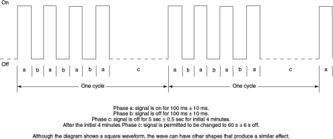Temporal Coding
Temporal coding is a type of distinctive evacuation signal in which an alarm pulses in order the convey a fire or a carbon monoxide (CO) alarm. Temporal-3 is used for fire, and Temporal-4 is used for carbon monoxide.
Temporal 3

Temporal 3 (sometimes "Code 3" or T3) became a NFPA requirement for building evacuation in July 1996[1] and has been recommended by other international standards[2]. Temporal-3 is a loop of three half-second pulses each separated by a half-second pause, followed by a 1.5 second pause before repeating. This has been proven to be effective for building evacuation[3]. Most audible notification appliances and fire alarm control panels built after the NFPA requirement include temporal 3 coding. The majority of smoke alarms manufactured after 2000 use temporal 3 instead of various other pulsating patterns or a continuous sound.
The intended meaning of the signal is for occupants to either evacuate or relocate from the space the signal is sounding.[4]
Temporal 4

Temporal 4 (T4) coding is a loop of four 100ms pulses followed by a 5 second pause[5] for the first four minutes of a CO alarm. After the first four minutes, the four pulses may sound once every minute. Similar to Temporal 3 for fire signaling, Temporal 4 is used for carbon monoxide signaling as it is a distinct pattern, although it is not intended to be an evacuation signal[6].
Carbon monoxide signaling is relativity new in fire alarm systems [citation needed]. Security systems usually also have CO detection support with Temporal 4 bell coding [citation needed].
Use in Notification Appliances
Certain horns and horn strobes like those on the Eluxa series and Gentex low frequency sounders has the ability to control which coding option is sounded using sync modules. T3/T4 is also available on newer sounder bases. And some panels can be programmed for temporal 3 and temporal 4 through the NAC/Bell circuit. This is available on security panels, where a siren can be coded to temporal 3 for fire, and temporal 4 for carbon monoxide. Combo smoke and carbon monoxide alarms will sound T3 for fire and T4 for carbon monoxide.
References
- ↑ Beginning July 1, 1996, NFPA 72®, National Fire Alarm and Signaling Code®, required that the building evacuation signal be the temporal-three sound. https://www.nfpa.org/news-blogs-and-articles/blogs/2021/01/22/low-frequency-fire-and-smoke-alarms#:~:text=Beginning%20July%201%2C%201996%2C%20NFPA,tone%20of%20about%203150%20Hz.
- ↑ "Temporal 3 Fire Alarm Systems have become a norm in all buildings as the NFPA and other international standards recommend them." https://www.ny-engineers.com/blog/temporal-3-fire-alarm-systems
- ↑ "Such a pattern has been proven to be effective in alerting occupants and emergency responders about an imminent fire occurrence in the building."https://www.ny-engineers.com/mep-engineering-services/fire-protection-services/temporal-fire-alarm-system-design
- ↑ NFPA 72: National Fire Alarm and Signaling Code, 2022 edition, A.18.4.2.1. National Fire Prevention Association. Retrieved 13 August 2024.
- ↑ https://up.codes/s/distinctive-carbon-monoxide-audible-alarm-signal
- ↑ NFPA 72: National Fire Alarm and Signaling Code, 2022 edition Handbook Commentary, 18.4.3.2. National Fire Prevention Association.Retrieved 13 August 2024.

